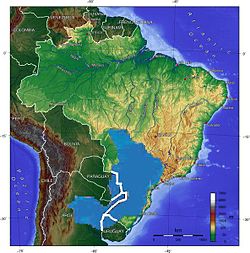
cross-referenced news and research resources about
Guarani Aquifer
The Guarani Aquifer, located beneath the surface of Argentina, Brazil, Paraguay, and Uruguay, is the second largest known aquifer system in the world and is an important source of fresh water. Named after the Guarani people, it covers 1,200,000 square kilometres (460,000 sq mi), with a volume of about 40,000 cubic kilometres (9,600 cu mi), a thickness of between 50 metres (160 ft) and 800 metres (2,600 ft) and a maximum depth of about 1,800 metres (5,900 ft). It is estimated to contain about 37,000 cubic kilometres (8,900 cu mi) of water, with a total recharge rate of about 166 km³/year from precipitation. It is said that this vast underground reservoir could supply fresh drinking water to the world for 200 years. However, at closer inspection, if the world population were to stay at an equilibrium of about 6.96 billion, not even taking into account that babies need less water than grown adults, this figure reaches 1600 years, allowing about 9 liters per day per person. Due to an expected shortage of fresh water on a global scale, which environmentalists suggest will become critical in under 20 years, this important natural resource is rapidly becoming politicised, and the control of the resource becomes ever more controversial.
|

Guarani Aquifer map
|

|
updated Sun. July 21, 2024
-
Mintpress News
February 24, 2018
New Europe
February 12, 2018
Center for Research on Globalization
February 1, 2018
But the real predators of water and those that are massively privatizing the last uncontaminated sources of water in, for example, Amazon's huge aquifers and the Guarani fossil aquifer, arguably the world's largest freshwater reserve, are the giant water corporations like the French Veolia, and ... War
The Guardian
January 25, 2018
The property sits on a groundwater recharge area of the Guarani aquifer, one of the world's biggest reserve of fresh water. These facts tipped the scales in the squatters' favour, and in 2007 - four years after the initial occupation - the MST and the government reached an agreement to expropriate the land. Brazil
teleSUR English
December 20, 2017
Green Left Weekly
August 12, 2017
We are gathered here in Cuchilla del Fuego, in the department of Paysandu, Uruguay, because the Guarani Aquifer system is being assaulted by perforations being carried out by an oil company and is under threat from the chemical and radioactive pollution that could arise from these activities. Anti-fracking activists
Intercontinental Cry
May 31, 2017
The Guarani Aquifer is the largest underground aquifer in the world and the third largest underground water reserve in the world. The Aquifer, named after the Guarani Peoples, lies underneath a huge region of land that stretches across Brazil, Paraguay, Uruguay and Argentina. It is estimated to ...
|
news and opinion
|
|
|
guarani aquifer
South America aquifers:
guarani aquifer
|
|